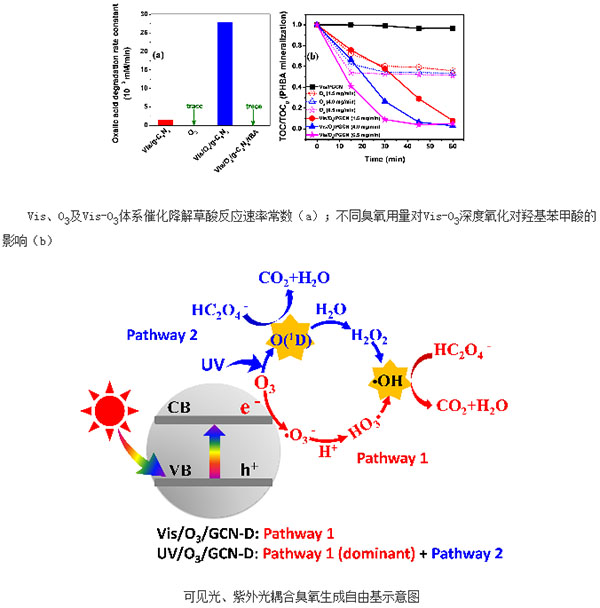
The advanced oxidation technology is a deep water treatment technology based on the strong oxidation of hydroxyl radical (?OH), including photocatalysis, ozone oxidation, Fenton reaction, wet catalytic oxidation and the like. Among them, photocatalysis can convert light energy into chemical energy, oxidatively decompose organic matter, and is expected to directly use sunlight to develop a clean water purification process, which has attracted widespread attention. However, the ability of photocatalytic oxidation of organic materials is extremely weak and the reaction time is long, which restricts its industrial application. At present, photocatalytic research mostly uses oxygen molecules (E0 = 1.23 V) to capture photo-generated electrons, while ozone (E0 = 2.07 V) has a stronger ability to capture photo-generated electrons, which can effectively reduce the recombination rate of electrons and holes. At the same time, photo-generated electrons can accelerate ozone. Self-decomposition promotes the formation of active free radicals and enhances the mineralization ability of the process. In the past two years, Xie Yongbing, associate researcher of the process pollution control environmental engineering team of the Institute of Process Engineering, Chinese Academy of Sciences, has been working to couple photocatalysis with ozone oxidation to build a new ozone-photo-oxidation water treatment technology with higher oxidation efficiency.
In 2015, the research team published an overview of the topic of "catalytic ozone-optical coupling technology" (Chemosphere 2015, 121, 1-17 doi:10.1016/j.chemosphere.2014.10.072). For the first time, the process of catalytic materials, reaction device design, operating parameters, dynamics, internal mechanism, economic feasibility, development trends, etc., have been thoroughly discussed, providing theoretical guidance for researchers in this field. At the same time, it was first proposed to use graphite phase carbon nitride (g-C3N4) to catalyze the ozone-photocatalytic process and build (sun) visible light/ozone/g-C3N4 deep mineralization technology. The g-C3N4 can induce strong coupling between photocatalytic and ozone oxidation, with a coupling factor of up to 20 for target pollutants and TOC removal (Catal. Commun. 2015, 66, 10-14 doi:10.1016/j.catcom. 2015.03.004).
The bottom position of the g-C3N4 conduction band is higher, and the photoelectron reduction capacity is stronger. The enhanced ozone captures the photoelectron process and synergistically promotes electron-hole separation and ozone self-decomposition to OH. Under the same light intensity, the visible light/ozone/g-C3N4 oxidation ability is obviously stronger than that of UV/ozone/g-C3N4, and different free radical generation mechanisms under visible light and ultraviolet light are proposed (Appl. Catal. B: Environ. 2016, 181, 420-428 doi:10.1016/j.apcatb.2015.08.020). On this basis, they successfully developed the second-generation honeycomb-like porous g-C3N4 catalyst, which significantly improved visible light photocatalytic activity. The combination of radical quenching experiments and electron spin resonance spectroscopy reveals the evolution of free radicals in the coupling process and combines the detection of intermediates to propose a contaminant full mineralization pathway (Appl. Catal. B: Environ. 2016, 183, 417- 425 doi:10.1016/j.apcatb.2015.11.010).
This series of work for the first time builds a visible light/ozone/g-C3N4 advanced oxygenated organic degradation platform that is expected to directly utilize sunlight to develop a highly efficient, clean, low cost water purification process, and has the potential for the development of coupled oxidation catalysts, evolution of free radicals, and deep oxidation of organic matter. Guiding significance. The above work applies for domestic invention patents and international invention patents. The work was funded by the National Natural Science Foundation of China (No. 21207133) and the National Outstanding Youth Fund (No. 51425405). The work was completed by the doctoral student Xiao Jiadong.
Nickel Alloy Steel Boiler Tube
Nickel And Nickel Alloys
Nickel is a versatile, highly corrosion resistant element that will alloy with most metals. Due to its corrosion resistance, nickel is used to maintain product purity in the processing of foods and synthetic fibers. It is highly resistant to various reducing chemicals and is unexcelled in resistance to caustic alkalies. In addition, nickel has good thermal, electrical and magnetostrictive properties. Relatively high thermal conductivity of this metal has lead to its frequent use for heat exchangers
Commercially pure or low-alloy nickel may contain very small amounts of alloying elements to absolutely none. By contrast nickel alloys contain significant amounts of added elements. Nickel and nickel alloys are both non-ferrous metals that are useful in a range of applications, most of which involve corrosion resistance and/or heat resistance.
Nickel Alloy alternatives to trademark [brand" names.
Alloy C276 alternative to Hastelloy C-276 and Hastelloy C
Alloy B-2 alternative to Hastelloy B-2
Alloy C-22 alternative to Hastelloy C-22
Alloy X alternative to Hastelloy X and Inconel HX
Alloy 20 alternative to Carpenter 20 and Incoloy 20
Alloy718 alternative to Inconel 718
Alloy 800 alternative to Incoloy 800
Alloy 800H/HT alternative to Incoloy 800H/HT
Alloy 400 alternative to Monel 400
Alloy K-500 alternative to Monel K-500
Alloy 625 alternative to Inconel 625
Alloy 600 alternative to Inconel 600
Alloy 601 alternative to Inconel 601
Nickel Alloy Boiler Tube,Nickel Alloy Seamless Tube,Astm Nickel Alloy Boiler Tube
YUHONG HOLDING GROUP CO.,LIMITED , https://www.alloypipeline.com
